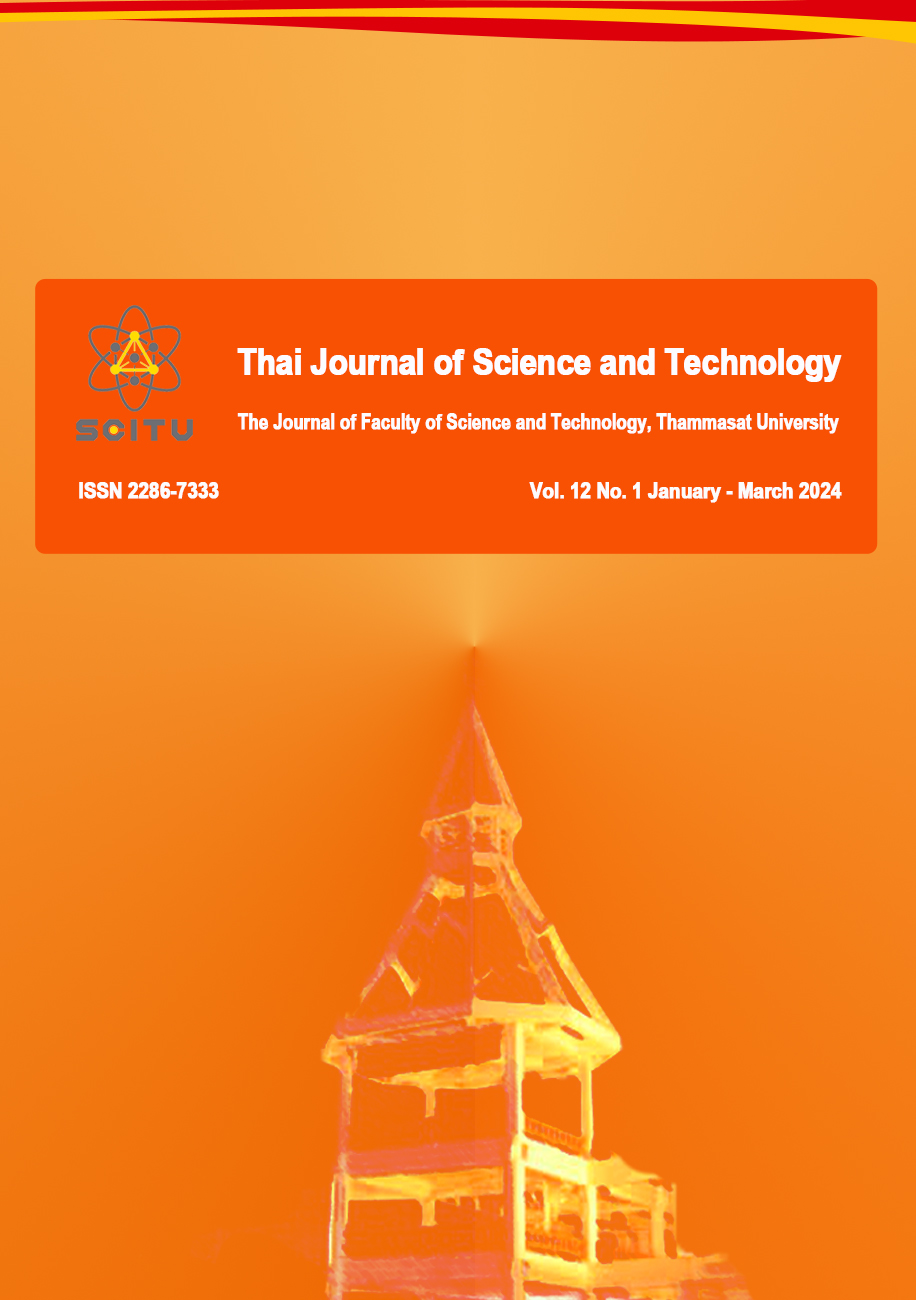A Plant Simulation Approach Applied Sequencing Strategies for Buffer Prediction: A Case Study in an Automotive Assembly Line
Main Article Content
บทคัดย่อ
In this study, a plant simulation approach to buffer prediction for an automotive assembly line was proposed. Currently, the assembly line has exceeded the buffer size. The idea to reduce buffer size is to increase worker size and sequencing strategy. With simulation, two approaches, including throughput analysis and production time analysis, are proposed. The throughput analysis can find the required buffer sizes for maximizing throughput when the total available time is used. The production time analysis can determine the time spent using each buffer space with a fixed throughput size.
In terms of results, the sequencing strategy that produces two normal models and one new model provides the first plan to implement. Without increasing worker size, this strategy can finish 48 cars per shift by using 8 buffer spaces. Moreover, increasing one worker is the second plan so that
the throughput of this strategy can reach 58 cars per shift. Additionally, this simulation model highlights the modified Blocking After Station (MBAS) that can define not only buffer usage but also the buffer requirement. This research offers a simulation approach to the prediction of buffet usage and the requirement to define an action plan for an unfamiliar task in the automotive assembly line.
Article Details

อนุญาตภายใต้เงื่อนไข Creative Commons Attribution-NonCommercial-NoDerivatives 4.0 International License.
บทความที่ได้รับการตีพิมพ์เป็นลิขสิทธิ์ของคณะวิทยาศาสตร์และเทคโนโลยี มหาวิทยาลัยธรรมศาสตร์ ข้อความที่ปรากฏในแต่ละเรื่องของวารสารเล่มนี้เป็นเพียงความเห็นส่วนตัวของผู้เขียน ไม่มีความเกี่ยวข้องกับคณะวิทยาศาสตร์และเทคโนโลยี หรือคณาจารย์ท่านอื่นในมหาวิทยาลัยธรรมศาสตร์ ผู้เขียนต้องยืนยันว่าความรับผิดชอบต่อทุกข้อความที่นำเสนอไว้ในบทความของตน หากมีข้อผิดพลาดหรือความไม่ถูกต้องใด ๆ
เอกสารอ้างอิง
Alfieri, A., Matta, A., & Pastore, E. (2016). A column generation algorithm for the Buffer Allocation Problem approximated by the Time Buffer concept. IFAC-PapersOnLine, 49(12), 739–744.
Chiba, E. (2015). Heuristics for the Buffer Allocation Problem with collision probability using computer simulation. Mathematical Problems in Engineering, 2015, 1–7.
Costa, A., Alfieri, A., Matta, A., & Fichera, S. (2015). A parallel tabu search for solving the Primal Buffer Allocation Problem in serial production systems. Computer & Operations Research, 64, 97–112.
Hannes, A., John, W., Daniel, N., Jonatan, B., Björn, J., Karl, L., & Thomas, L. (2019). Utilizing discrete event simulation to support conceptual development of production systems. In 2019 Winter Simulation Conference (WSC) (pp. 2073–2084). USA.
Hema, V., & He, T. (2022). Throughput Analysis for Manufacturing Serial Systems using Discrete-Event Simulation and Analytical Calculation. Engineering & Technology Review, 3(1), 15–28.
Kolb, O., & Gottlich, S. (2015). A continuous buffer allocation model using stochastic processes. European Journal of Operational Research, 242(3), 865–874.
Kose, S., Demir, L., Tunali, S., & Eliiyi, D. (2015). Capacity improvement using simulation optimization approaches: A case study in the thermotechnology industry. Engineering Optimization, 47(2), 149–164.
Lang, L., Chwif, L., & Pereira, W. (2022). Decision-Making Impacts of Originating Picking Waves Process for a Distribution Center Using Discrete-Event Simulation. In 2022 Winter Simulation Conference (WSC) (pp. 1509–1520). Singapore.
Li, J. (2013). Continuous improvement at Toyota manufacturing plant: Applications of production systems engineering methods. International Journal of Production Research, 51(23–24), 7235–7249.
Li, L., Qian, Y., Du, K., & Yang, Y. (2016). Analysis of approximately balanced production lines. International Journal of Production Research, 54(3), 647–664.
Matta, A., Pedrielli, G., & Alfieri, A. (2014). Event Relationship Graph Lite: Event based modeling for simulation-optimization of control policies in discrete event systems. In Proceedings of the 2014 Winter Simulation Conference (pp. 3983–3994). USA.
Pedrielli, G., Alfieri, A., & Matta, A. (2015). Integrated simulation-optimization of pull control systems. International Journal of Production Research, 53(14), 4317–4336.
Prasad, T., & Ramesh, L. (2019). Application of Discrete-Event Simulation to Increase Throughput of Manufacturing System—A Case Study. In Proceedings of International Conference on Intelligent Manufacturing and Automation. Lecture Notes in Mechanical Engineering (pp. 531–539). Springer, Singapore.
Smith, J. (2016). Joint optimization of buffers and network population for closed finite queueing systems. International Journal of Production Research, 54(17), 5111–5135.
Staley, D., & Kim, D. (2012). Experimental results for the allocation of buffers in closed serial production lines. International Journal of Production Economics, 137(2), 284–291.
Tsadiras A., Papadopoulos, C., & O’Kelly, M. (2013). An artificial neural network based decision support system for solving the Buffer Allocation Problem in reliable production lines. Computers & Industrial Engineering, 66(4), 1150–1162.
Vergara, H., & Kim, D. (2009). A new method for the placement of buffers in serial production lines. International Journal of Production Research, 47(16), 4437–4456.
Vidanelage, L., Hebah, M., Mohammad, N., & Aziz, A. (2020). A discrete event simulation (des) based approach to maximize the patient throughput in outpatient clinic. Engineering Science & Technology Journal, 1(1), 1–11.
Weiss, S., & Stolletz, R. (2015). Buffer allocation in stochastic flow lines via sample-based optimization with initial bounds. OR Spectrum, 37(4), 869–902.
Weiss, S., Matta, A., & Stolletz, R. (2018). Optimization of buffer allocations in flow lines with limited supply. IISE Transactions, 50(3), 191–202.


